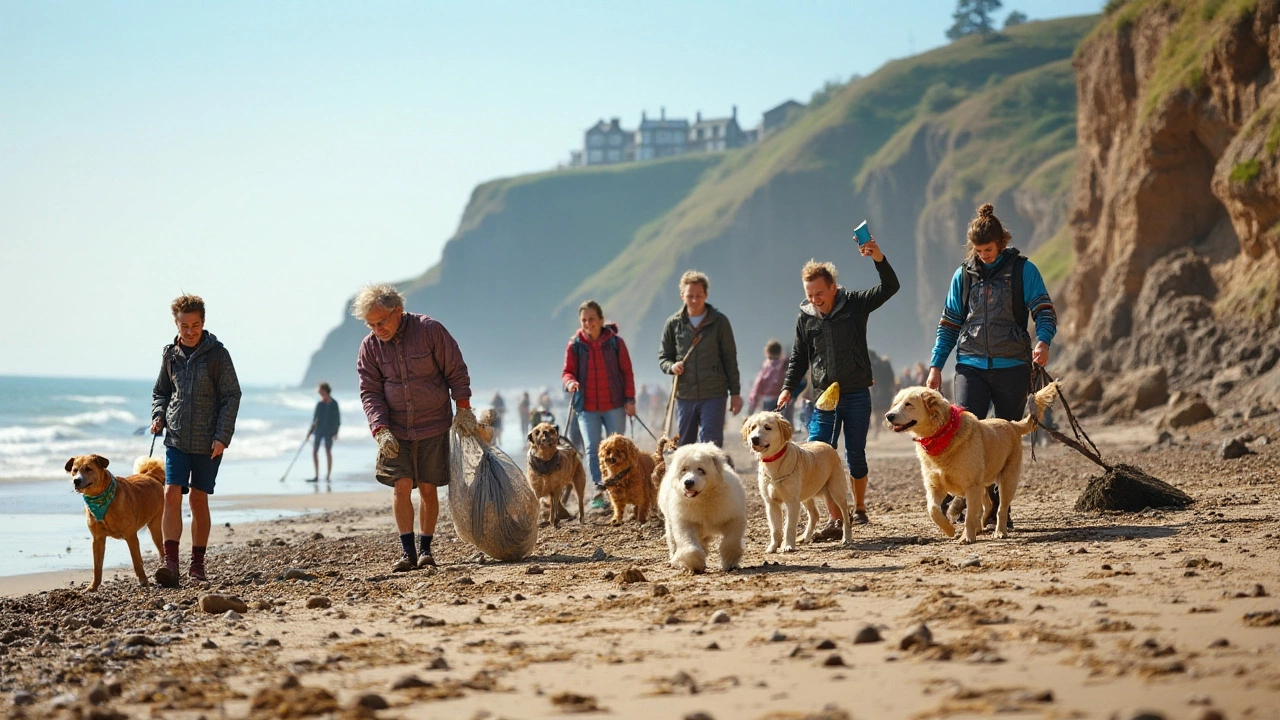There's something irreplaceable about the joy of sprinting along the shoreline with your dog, the wind in both your hair and fur, the rhythmic lull of waves keeping time with joyous barking. As many pet owners know, including our four-legged companions in every adventure elevates the experience to something truly special. But before you leash up and hit the sandy trails, knowing the specifics about dog policies at National Seashore locations is essential.
These beautiful stretches of preserved coastline offer an idyllic escape, but ensuring a positive experience requires more than just showing up with a leash and a frisbee. Understand where dogs are welcome, the local rules and guidelines, and how you can not only enjoy the joys of a beach day but also contribute to the conservation efforts that keep these places beautiful. Dive into this guide for an enriching beach day both you and your dog will treasure.
- Dogs at National Seashore: Rules and Guidelines
- Planning Your Visit: Tips for Dog Owners
- Top Dog-Friendly National Seashores
- Respectful Co-existence: Protecting the Environment
Dogs at National Seashore: Rules and Guidelines
Every beach-loving dog owner dreams of a sunny day spent at a pristine national seashore where their pup can frolic freely and feel the cool water tickle their paws. But before packing up the beach towels and heading out, it's crucial to understand that each National Seashore has its own set of rules and guidelines when it comes to dogs. These places are not just stretches of sandy paradise but delicate ecosystems that require respect and preservation. Typically, dog-friendly beaches within these areas will have clear guidelines posted about where pets are permitted. In many places, dogs must be on a leash no longer than six feet, both for their safety and the protection of wildlife.
Alongside leash regulations, there are usually specified hours when dogs are allowed on the beaches, designed to balance visitor enjoyment with environmental protection. For example, at Cape Cod's National Seashore, dogs are welcome on the beaches before 9 AM and after 6 PM during the peak season to avoid interfering with nesting shorebirds, which is essential for maintaining biodiversity. Some areas, like Point Reyes, have stricter guidelines due to the sensitive nature of their habitats. This can mean certain trails and sections of the beach are off-limits to pets entirely.
Keeping updated on local guidelines is part of responsible pet ownership. These rules aren't in place to deter you but to ensure the coexistence of humans, dogs, and wildlife. The National Park Service regularly updates information about these guidelines, giving visitors a chance to plan their trips accordingly. It's also important to pack essentials for ethical beach visits: bring biodegradable waste bags, plenty of water, and maybe even a portable shade for your furry friend. Water safety is another thing to consider; not every dog is a born swimmer, and with ocean currents being unpredictable, keeping them on a leash near the water might just save their life.
If you're skeptical about navigating these rules, you're not alone. As David Winkler, a noted environmental scientist, once stated,
"Balancing human recreation with wildlife conservation is among our highest priorities. Simple efforts by individuals lead to broader, impactful preservation."Understanding and adhering to these guidelines contributes to the long-term goals of these protected areas, ensuring that seashores remain beautiful and welcoming for future generations of both people and pets.

Planning Your Visit: Tips for Dog Owners
Heading to a National Seashore with your dog is a delightful way to bond and enjoy the great outdoors, but a little planning goes a long way in making the day hassle-free. Before embarking on your sandy escapade, it's essential to research the specific dog policies for the dog-friendly beaches you're considering. Each National Seashore has its guidelines, and understanding them ensures a smooth trip. Look for details on designated dog-friendly areas and leash regulations. It's often required to keep your furry buddy on a lead, not just for their safety but to respect wildlife and other visitors.
Once you've got the rules down, pack smart. Carry essentials like water, a collapsible bowl, waste bags, and snacks. Shade is also crucial, especially on hot summer days, so bring an umbrella or a portable tent. A simple first-aid kit can be handy for unexpected scrapes or bug bites. Check the weather forecast; knowing what to expect can save you from blustery winds or unexpected showers. Also, sunscreen isn't just for humans! Certain dog breeds can get sunburned too, particularly the ones with short or thin coats, so consider investing in pet-safe sunscreen.
Your dog's comfort is paramount. Let them adjust to new surroundings at their own pace. Some dogs may leap right into the waves, while others might prefer a relaxed stroll along the tide mark. A bit of encouragement and positive reinforcement makes all the difference. Exploring the shoreline, digging, and fetching are great ways to expend energy. While doing so, stay mindful of other people's space and pets. Not all beachgoers are comfortable around dogs. Keep a respectful distance and a vigilant eye.
Lastly, an often forgotten yet crucial tip is timing your visit wisely. Early mornings and late afternoons are typically cooler and less crowded, offering a more relaxed vibe. Plus, you might catch a breathtaking sunrise or sunset. An important nugget of wisdom from seasoned pet travelers is, "A tired dog is a happy dog."
"A well-exercised pup will make for a well-behaved companion," says renowned dog trainer and author Emily Larlham.Make the most of your excursion by ensuring your pup enjoys enough playtime to relax contentedly at the day’s end.
Safety extends beyond the beach. Use a reliable collar that displays identification and consider a GPS tracker for extra peace of mind. Staying connected with your pet is critical, especially if they tend to wander off. Post-visit, it's a good idea to rinse off saltwater and sand from their coat to prevent irritation. Check their paws for any cuts or debris stuck between toes. By following these steps, your trek to the tides will likely be an unforgettable adventure, cherished by both you and your four-legged friend.

Top Dog-Friendly National Seashores
Exploring the great outdoors with your canine companion is a joy unlike any other, and there are few places more inviting than the stunning tapestry of America's National Seashores. These locations, scattered along the coasts, provide a heavenly backdrop for a day of sun and play. But not all seashores are created equal when it comes to welcoming our furry friends. Understanding each site's laws and facilities can ensure a seamless day filled with saltwater and sand without a hitch. Cape Cod National Seashore is one iconic spot, known for its sprawling shoreline and rich history. Here, dogs are allowed on certain beaches as long as they're leashed, except during nesting seasons of particular shorebirds, which is something every visitor should be mindful about. The vibrant landscape reveals a marriage of oceanic blue and lush greens, offering plenty of sniff-friendly trails for you and your pup to explore.
Another gem on the eastern seaboard is the Assateague Island National Seashore, where wild horses gallop and the rules are equally accommodating for dogs. Welcoming dogs year-round, the island offers a scenic blend of marshland, dunes, and forest trails where your dog can enjoy the natural aromas of the coastal biome. But here too, leashes are non-negotiable—it’s both a measure of safety and courtesy. Located on the border between Maryland and Virginia, the island extends for miles, offering so much for both you and your dog to take in.
If a taste of the Gulf is more your speed, the Padre Island National Seashore in Texas should be on your radar. Here, dogs are warmly accepted down the world's longest stretch of undeveloped barrier island. This slice of paradise beckons with wide sandy shores, perfect for long walks and dolphin watching. During nesting season, however, certain restrictions come into play to protect the local wildlife, a vital aspect of maintaining harmony with nature.
"Dogs enrich every outdoor experience with their boundless enthusiasm and infectious energy. It's important for us—as responsible pet owners—to protect these lands in return," notes a renowned wildlife conservationist.Visiting any of these seashores not only rewards you with exceptional views but also fosters an appreciation for the delicate ecosystems that thrive there, both for you and your dog.
A crucial aspect of enjoying a dog-friendly beach holiday is adhering to each park's guidelines and respecting the environment. Many of these seashores provide convenient amenities like dog waste stations and clearly marked 'no dog zones', illustrating a balanced approach to conservation. After all, preserving these pristine habitats ensures that we can continue to enjoy them with our dogs in tow for years to come.
Below is a table summarizing the key details about these seashores:
| Seashore | Dog Policy | Highlight Features |
|---|---|---|
| Cape Cod National Seashore | Dogs allowed on leash except during bird nesting seasons | Scenic trails, eco-rich landscapes |
| Assateague Island National Seashore | Dogs allowed on leash all year | Marshland, wild horses, forest trails |
| Padre Island National Seashore | Dogs allowed on leash with restrictions during nesting season | Longest undeveloped barrier island, dolphin watching |

Respectful Co-existence: Protecting the Environment
When planning a visit to any National Seashore with your furry friend, it's crucial to merge fun with responsibility, particularly when it comes to environmental protection. National Seashores are not just picturesque locations for your dog's playtime; they are thriving ecosystems hosting a vast array of plant and animal species. The balance of these ecosystems relies on our respectful co-existence, and as more people recognize these spaces as dog-friendly beaches, understanding and acting in conservation-friendly ways become vital. For instance, it's important to stick to designated trails and pathways when traversing dune areas. These dunes not only act as natural barriers against coastal erosion but are also critical habitats for various indigenous creatures like the elusive Piping Plover, whose nesting grounds can be easily disturbed by unaware visitors.
Ensuring your dog stays on a leash in designated areas is more than just a rule; it's a necessity for protecting both wildlife and your pet. Dogs, with their natural instincts, might chase birds, dig into nests, or disturb ground-dwelling creatures. In doing so, they can unintentionally harm fragile species. According to a study by the National Park Service, leash rules have helped to significantly reduce the disturbance to wildlife in coastal areas, highlighting the effectiveness of these guidelines.
Leave No Trace
The Leave No Trace principles are an excellent guideline for beach-goers with dogs. This includes picking up after your pet to maintain cleanliness and prevent pollution. Dog waste can introduce pathogens into the sand and water, risking the health of both wildlife and human visitors. Waste bags are often provided at many national seashore pets areas, but it's wise to carry your own supply to ensure you're always prepared. Take the extra step to pack in and pack out everything you bring along, so these precious places continue to thrive.
As conservationist Aldo Leopold once said, "Harmony with land is like harmony with a friend; you cannot cherish his right hand and chop off his left." This wisdom reminds us that every choice we make as visitors has a ripple effect on the environment we love.
Another important aspect of responsible beach visits is understanding seasonal bans or restrictions, which protect wildlife during critical life stages like nesting or migration. These bans may affect specific areas of a beach or entire sections during particular times of the year. Before visiting, check for any advisories or special regulations on the National Seashore’s website to plan accordingly. By respecting these temporary restrictions, you are directly contributing to the survival of species that depend on the natural undisturbed rhythm of their habitat.
Remember always to share information with fellow beach-goers about the importance of these practices. Sometimes, just a simple conversation can increase awareness and spark a chain of responsible actions among a group of visitors. Enjoying the best of what beach holidays with dogs have to offer becomes a meaningful experience when combined with environmental stewardship. Every shared experience builds better understanding and appreciation for the natural world, ensuring that our beautiful seashores continue to be a sanctuary for all living beings.







